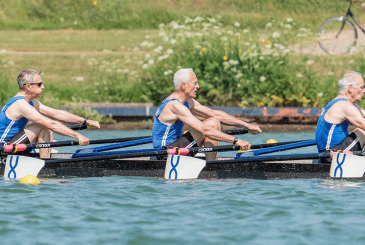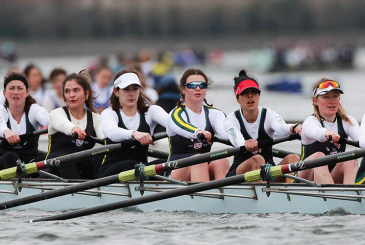Like Mockingjay for The Hunger Games or Return of the King for The Lord of the Rings, this article completes British Rowing Plus’s very own literary trilogy. Following our analyses of 2k and 5k racing, it’s now the turn of the 1k race. This article discusses the physiological demands, training required, race tactics, and nutritional considerations to optimise your speed over this distance. It also looks at how any of these may be different for Masters athletes, as this is the standard race distance for this category of competitive rowers.
Physiological demands
As discussed in our previous two articles, the length of a race determines the physiology required for its execution.
The longer the event, the more it relies on aerobic pathways for energy production. This is why the 5km is a useful marker of your winter base-training. 2km racing is a mix of aerobic energy demand and other non-aerobic (anaerobic) energy systems, making it the perfect distance for a strength-endurance sport like rowing.
A 1km race, while still dominated by endurance, leans more into non-oxidative energy/power production to fuel its completion. Anaerobic ‘pathways’ can provide lots of energy, but not for long because production affected by the build up of waste products and associated acidity in the muscles. Humans can use phosphocreatine to produce energy for very short (approximately 10 second) bursts, or anaerobic glycolysis (the breakdown of glucose, often referred to as the ‘lactic acid’ system) for slightly less intense and longer efforts – perfect for a four-minute competition.
Training for 1k races
Nevertheless a decent aerobic base is still crucial. Our ability to consume oxygen to produce energy is highly trainable, so it makes sense to spend considerable time developing it. In previous articles I have compared rowing physiology to making a cake – you spend the winter ‘baking’ a big, stable base, and then the summer adding the icing to the top. Despite the increased importance of the icing for a 1,000m race, the bigger the base, the more room you have for it. The middle section (minutes 2 and 3) of the race is relatively stable and governed by our cardio-vascular system. Regular long-steady, low intensity rows should make up approximately 70-80% of a balanced training programme as this is the smart way to develop the systems that improve our endurance physiology.
The value of strength training
Strength training is also a vital component of training for a 1k race. This is also where we should consider the specific requirements of the Masters athlete. As we age, we lose both muscle mass and the ability to recruit our remaining muscle (see a previous article looking at the effects of aging on rowing). In an event which relies heavily on strength and power, this places a large emphasis on weight room activity. Regular multi-muscle group strength training (1-2 times per week, 3 sets of 8-12 repetitions at ~85% of your 1 repetition maximum) can help reduce these losses and contribute to greater boat speed.
Sharpen up!
To get that boat speed, of course, you need to be able to transfer these strength gains to the technical delivery of a rowing stroke. High intensity/short-duration race rate pieces will help this, alongside causing metabolic adaptations that improve energy production. Consider interval sessions – short but hard efforts with rest periods (e.g. 15 seconds on / 45 seconds off, 5 times, with 5 minutes active recovery, twice).
Race tactics for 1k races
If we consider a 1k race as a truncated version of its longer cousins, a 4-minute race places significantly more emphasis on the start and end, as they make up a larger percentage of the performance. Overcoming the resistance of a hull sitting in water off the start requires maximal force production (particularly in bigger boats). Throw in a last 250m sprint that is a quarter of the total distance, and the opportunity for nuanced tactics are reduced. The short ‘mid-race’ has less time to be effective, so your best bet is to focus on your own boat and on delivering power at the highest maintainable limit, while saving something for the final push.
Consider what you do in your warm-up and how this might differ to longer distance races too. As previously mentioned, the need to generate power quickly is a key determinant of race outcomes, so bursts that prime the system for a high intensity start will make a difference when the race begins.
Nutrition for 1k races
Finally, let’s consider food. The intensity required for 1k races dictates that the energy produced is largely converted from carbohydrate, as the energy within it is so quick and easy to access (in comparison to fats). The time it takes also means that running out of such fuel is unlikely – in a single race.
However, the need to repeat this performance two, three, four or even more times, often repeatedly over up to four days, will have a substantial effect on stores of macro-nutrients. The key to replenishing glycogen (the stored form of glucose in the liver and muscle) is the type and timing of post-race nutrition.
Eat low-glycaemic index foods as soon as is tolerable after a race, and long enough before the next one as to not affect your preparation. There is a temptation is to use supplements, due to their designed convenience and energy to mass ratio. Rather, with planning, a food-first approach is possible. At the end of the day, eat a larger, balanced meal with 20g of protein to help repair damage (this also applies to weight training).
Summary
In conclusion, 1k races, despite being shorter, are no less challenging than longer versions.
The balance of aerobic vs anaerobic demand is shifted, but not far enough to diminish the importance of high volume, low intensity training.
Do not underestimate the value of high intensity work, supported by strength training (particularly for Masters athletes)!
However, when several performances (of increasing importance) are required over a weekend, the need to replenish stores and repair muscle damage are key.










